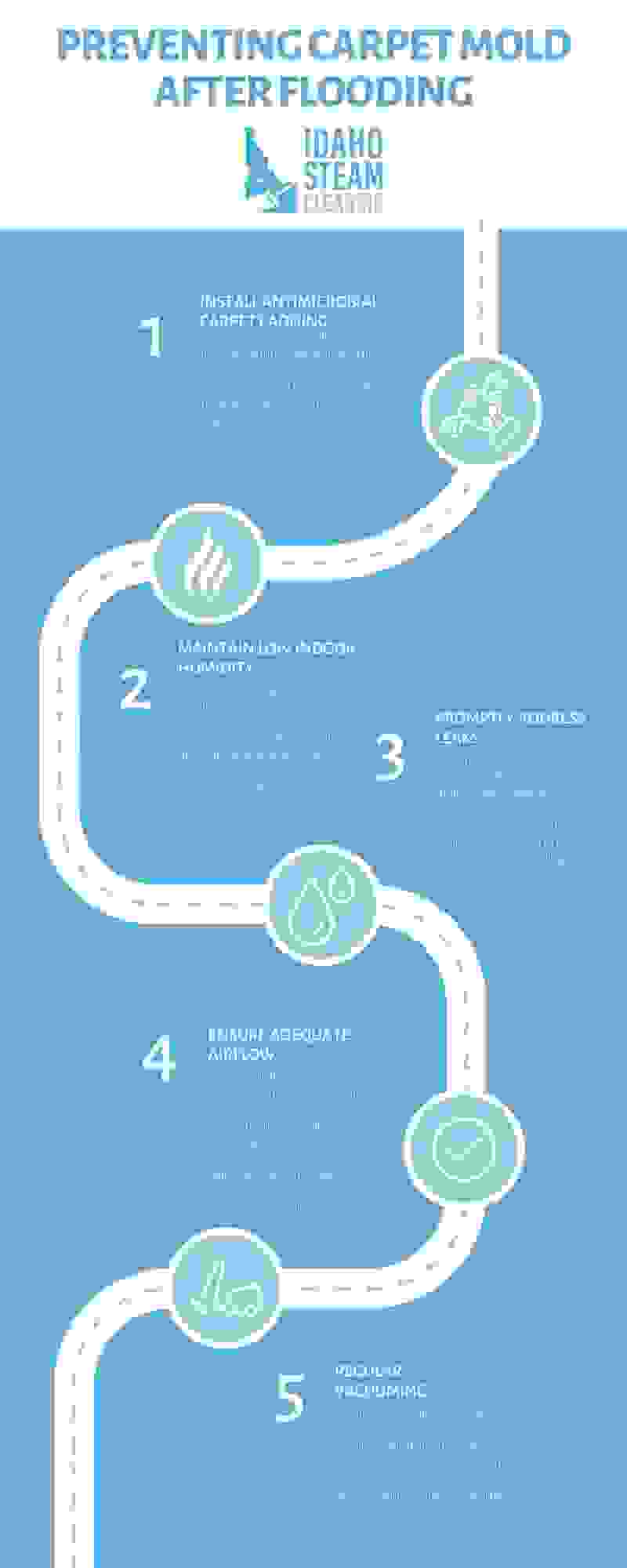Flooding or even minor leaks can have disastrous effects on your home, primarily leading to a pesky invader: mold. The battle to prevent carpet mold is real, but with the right approach, it can certainly be won. At our carpet cleaning service in Idaho Falls, we often assist homeowners with mold concerns. We've put together this detailed guide to help you understand how to avoid mold growth in carpets.
Table of Contents
- Understanding Carpet Mold
- Immediate Steps to Prevent Carpet Mold
- Long-term Strategies for Preventing Mold Growth
- Professional Carpet Cleaning
- Air Duct Cleaning and Mold
Understanding Carpet Mold
Mold is a menace that thrives in damp and warm conditions, with carpeting providing the perfect hideout. Prolonged exposure to mold can lead to health issues like respiratory problems, allergies, and, in extreme cases, neurological disorders. A 2004 study by the Institute of Medicine (IOM) found sufficient evidence to link indoor exposure to mold with upper respiratory tract symptoms, cough, and wheezing in healthy individuals.
Immediate Steps to Prevent Carpet Mold After a Flood or Leak
Preventing carpet mold begins with immediate action after a flood or leak. First, eliminate any standing water using a wet vacuum. Then, start drying out the area using fans or a dehumidifier.
Opening windows and doors can improve ventilation, but only if the outdoor air is less humid than the indoor air. Furthermore, steam cleaning can effectively kill mold spores and bacteria. These immediate steps go a long way in avoiding mold growth in carpets.
Long-term Strategies for Preventing Mold Growth
While immediate response is key, true victory over carpet mold lies in proactive, long-term prevention strategies. Creating an environment that is unfavorable for mold growth and incorporating regular maintenance measures can help you avoid mold growth in carpets.
Here are some strategies you can adopt:
Install Antimicrobial Carpet Padding: Choose a carpet padding that includes antimicrobial properties. This kind of padding is designed to inhibit mold and bacteria growth, making it harder for these organisms to thrive in your carpet.
Maintain Low Indoor Humidity: Mold thrives in high humidity conditions. Therefore, maintaining your indoor humidity below 60% can help prevent mold growth. Use dehumidifiers, especially in damp spaces like basements, to achieve this.
Promptly Address Leaks: Even minor leaks can create damp conditions that favor mold growth. Regularly inspect your home for any signs of leaks and fix them as soon as possible to prevent dampness from settling into your carpets.
Ensure Adequate Airflow: Poor ventilation can lead to increased moisture levels in your home, which can promote mold growth. Encourage better airflow by opening windows and doors, using fans, and moving furniture away from walls to allow air to circulate.
Regular Vacuuming: Regular vacuuming can help keep your carpets dry and clean, making it less likely for mold to grow. It’s especially important to vacuum in high-traffic areas and places where food or drink is often consumed.
Routine Professional Carpet Cleaning: Routine professional cleaning goes beyond the surface of your carpets to remove deep-seated dirt and moisture, making them less hospitable to mold.
By consistently implementing these strategies, you can help maintain the integrity and longevity of your carpets, and most importantly, keep your home safe and healthy.
Professional Carpet Cleaning: A Crucial Step to Prevent Carpet Mold
Homeowners can do a lot to prevent carpet mold, but professional carpet cleaning services have the necessary tools and expertise for thorough mold prevention. Professional carpet cleaners use high-grade tools and cleaning agents to deeply clean and sanitize carpets. They can also apply specialized treatments to inhibit future mold growth. Regular professional cleanings can keep your carpet healthy and prolong its lifespan.
Air Duct Cleaning and Mold: The Hidden Connection
Mold spores are microscopic, allowing them to travel freely throughout your home via your air ducts. Although they may not be visible, their impact can be detrimental. Here's where air duct cleaning becomes a significant part of preventing carpet mold.
Mold spores in your air ducts can circulate throughout your home, landing on various surfaces, including your carpets. Once these spores find a suitable environment – typically a warm, moist space – they can start to grow and multiply, leading to mold growth on your carpets and other areas.
Here's how regular air duct cleaning can help:
Reduces Mold Spores: Regular air duct cleaning can significantly reduce the number of mold spores circulating in your home. By physically removing dust and debris from your ducts, professional cleaners can eliminate many of the spores that could otherwise land on your carpets and grow into mold.
Improves Indoor Air Quality: Air duct cleaning doesn't just help with mold prevention; it also enhances your overall indoor air quality. Removing mold spores, dust, and other contaminants from your ducts means cleaner, healthier air in your home.
Prevents Mold in Air Ducts: Mold can actually grow inside your air ducts if they're humid and dirty. Regular cleaning helps to prevent this, removing the damp dust that mold needs to grow and improving the efficiency of your HVAC system to boot.
Expert Mold Detection: Professional air duct cleaners are trained to spot the signs of mold that the average homeowner might miss. They can identify potential mold issues before they become severe and guide you on the necessary steps to rectify the problem.
As part of a comprehensive strategy to prevent carpet mold, regular professional air duct cleaning offers substantial benefits. It's an often overlooked aspect of home maintenance that can make a big difference in your ongoing fight against mold.
Fight Back Against Mold
The fight to prevent carpet mold after a flood or leak can be overwhelming, but armed with knowledge and assistance from professional services, you can maintain a healthy, mold-free environment. Always remember: quick response, ongoing vigilance, and regular professional cleaning are your best defenses against mold.


